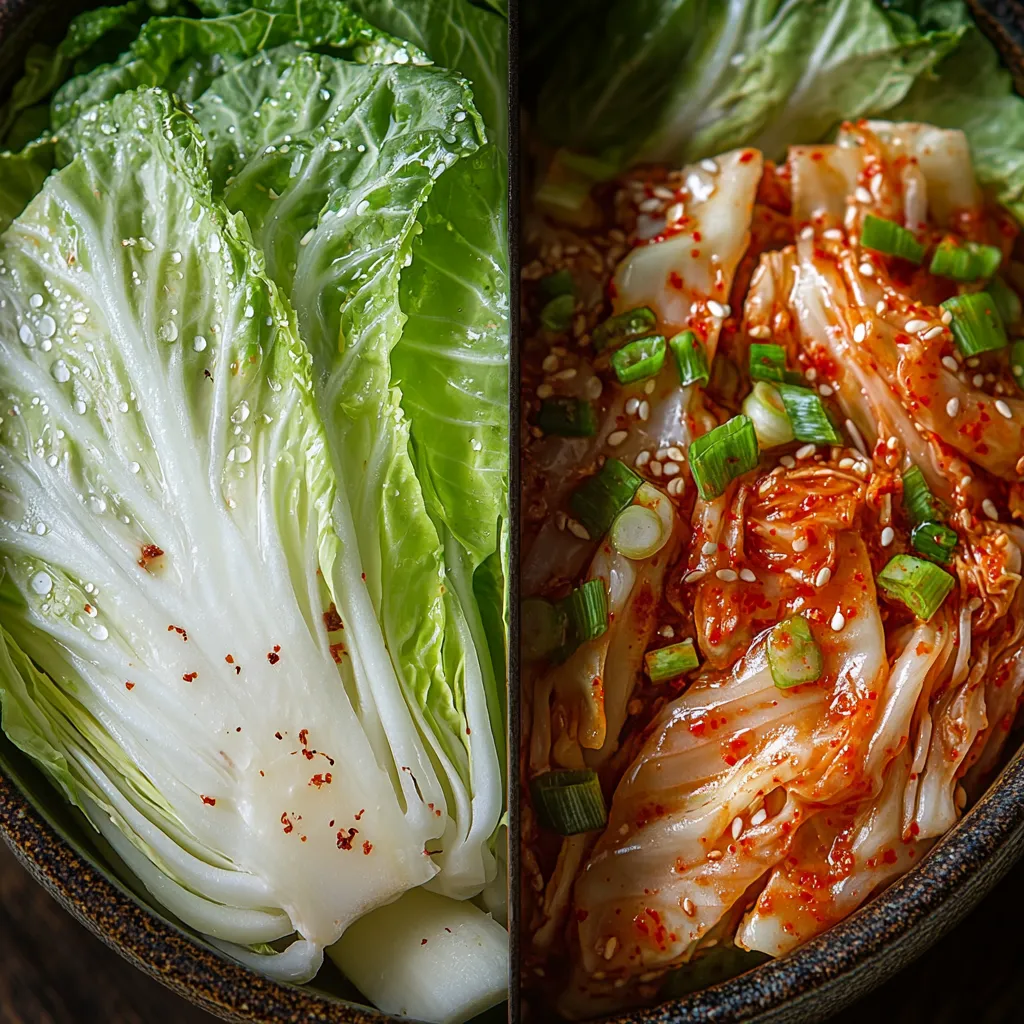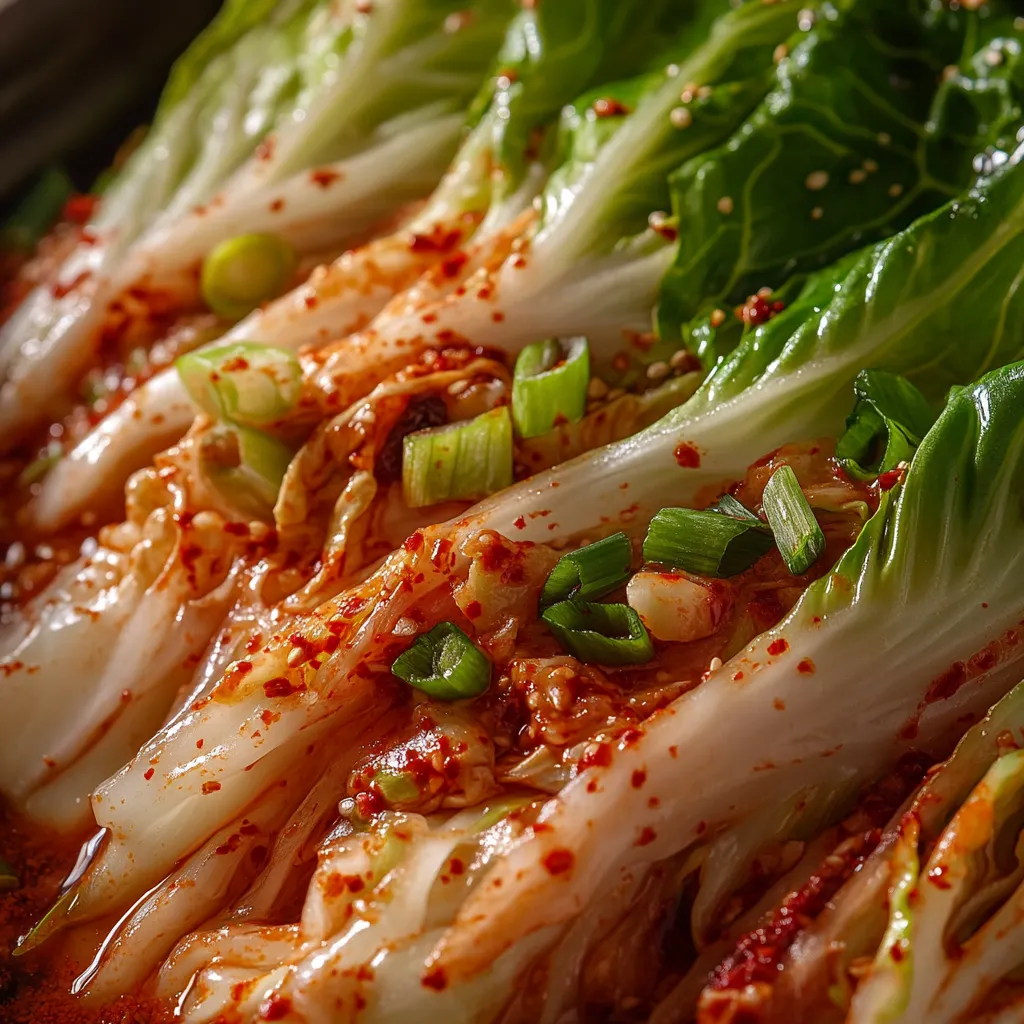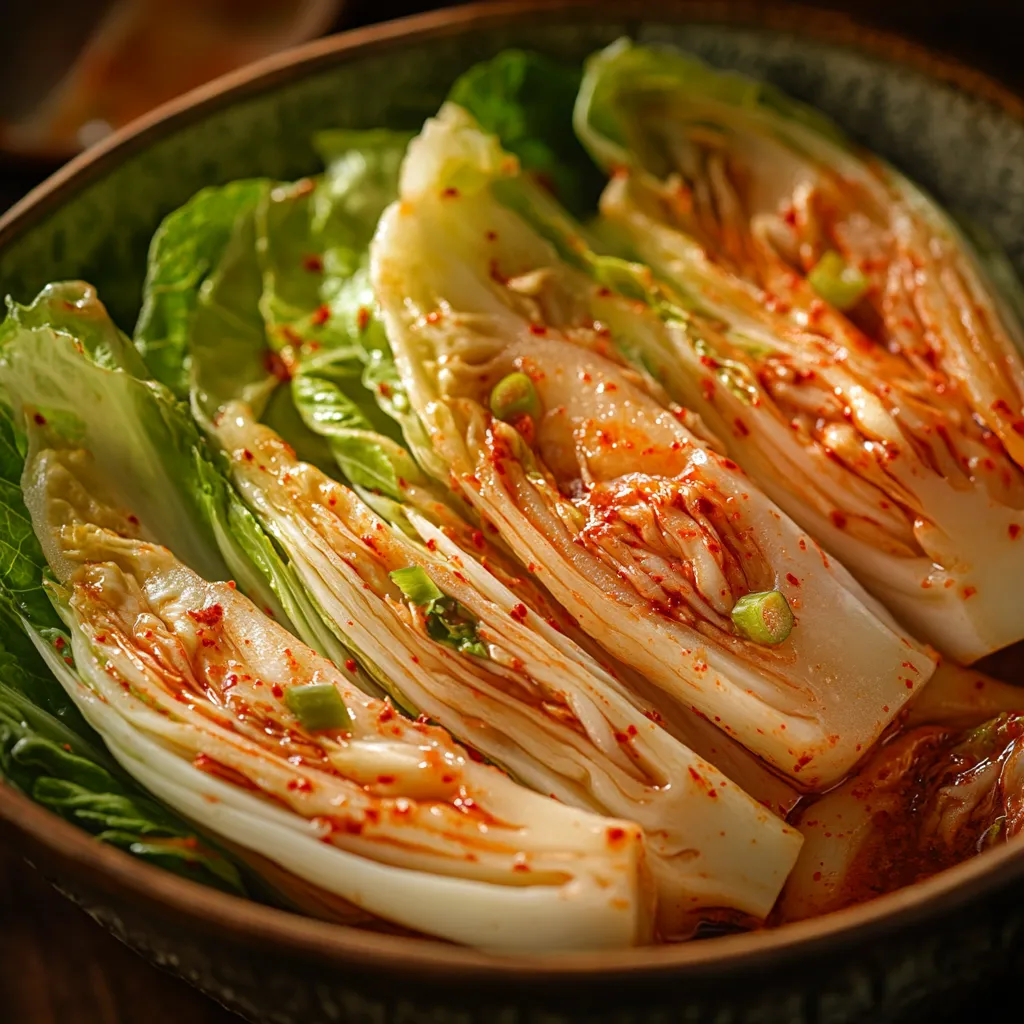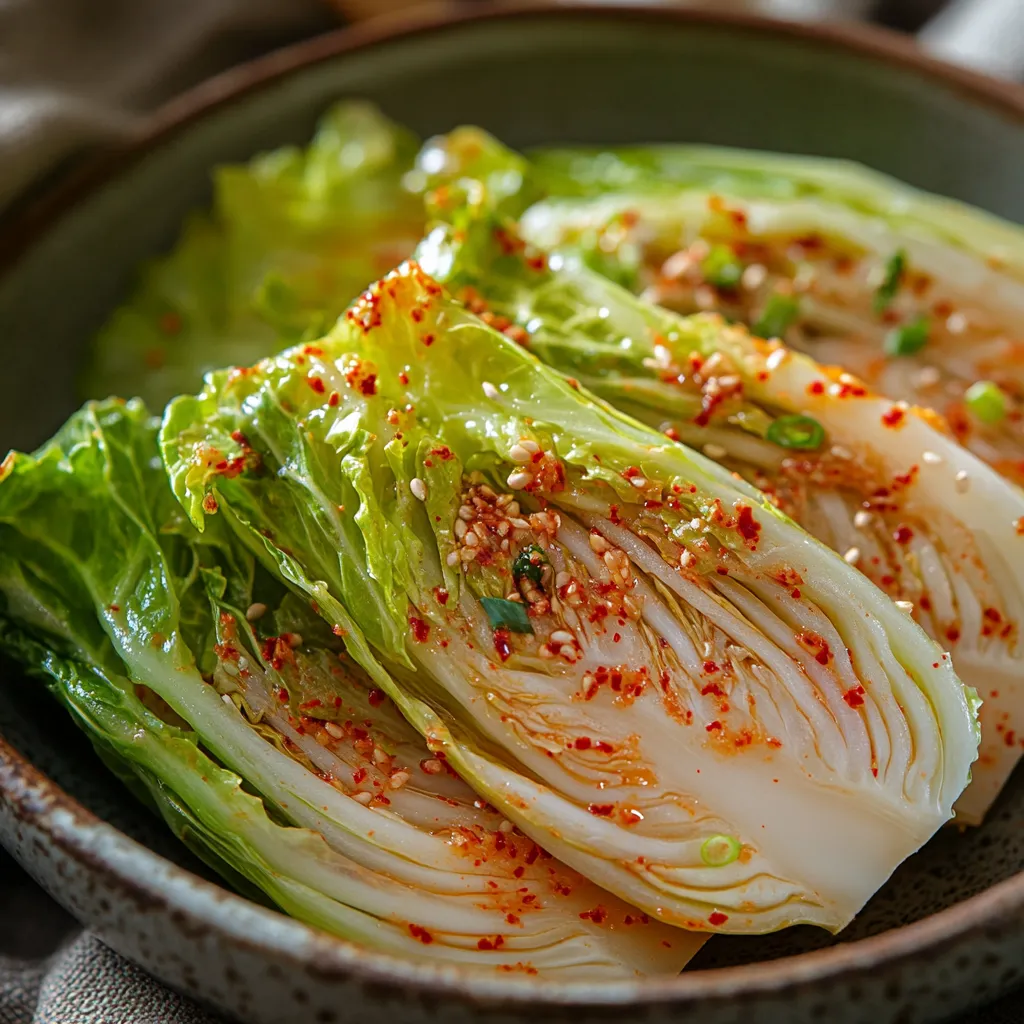Growing up, my grandmother’s kitchen was filled with the tantalizing aroma of fermenting vegetables. One of her specialties was kimchi, a staple in our household. I watched her meticulously prepare each ingredient, especially napa cabbage, which she often called the heart of kimchi. This made me wonder: Is napa cabbage the same as kimchi? This question often arises among food lovers, so let’s dive deep into this common misconception and explore the differences between napa cabbage and kimchi.

Table of content:
Is Napa Cabbage the Same as Kimchi? Understanding the Differences
Napa cabbage (Brassica rapa subsp. pekinensis) is a variety of Chinese cabbage that is widely used in Asian cuisine, particularly in Korean, Chinese, and Japanese dishes. However, while napa cabbage is commonly used to make kimchi, the two are not the same. The key difference lies in fermentation.
Kimchi is a fermented dish that involves seasoning napa cabbage (or other vegetables) with a blend of ingredients such as:
- Gochugaru (Korean chili flakes)
- Garlic and ginger
- Salt and fish sauce
- Fermented seafood paste (optional)
- Green onions and radish
The fermentation process, which takes anywhere from a few days to weeks, allows lactic acid bacteria to develop, giving kimchi its probiotic properties. According to Health Benefits of Kimchi, kimchi is known to improve gut health, boost immunity, and aid digestion. These health benefits make kimchi more than just a tasty dish—it is a nutritional powerhouse.
Why is Napa Cabbage the Preferred Choice for Kimchi?
Many people wonder why napa cabbage is the most popular vegetable used in making kimchi. The answer lies in its texture, flavor, and ability to absorb seasonings. Here’s why napa cabbage is ideal for kimchi:
- Absorbs Seasonings Well – The structure of napa cabbage allows it to soak up the spicy, savory, and umami flavors of the kimchi paste.
- High Water Content – This contributes to the juicy, crunchy consistency that makes kimchi enjoyable.
- Natural Sugars & Fiber – Help with the fermentation process, enhancing the probiotic benefits of kimchi.
For a deeper understanding of how napa cabbage plays a role in fermentation, check out The Fermentation Process of Vegetables.
Types of Kimchi That Don’t Use Napa Cabbage
While napa cabbage is the most popular base, there are over 100 types of kimchi! Some famous variations include:
- Radish Kimchi (Kkakdugi) – Uses cubed radish instead of cabbage, offering a crunchy and slightly sweet taste.
- Cucumber Kimchi (Oi-sobagi) – Features stuffed cucumbers soaked in chili paste, providing a refreshing, crisp bite.
- Green Onion Kimchi (Pa-kimchi) – Made with fermented green onions and a spicy sauce, commonly enjoyed with grilled meats.
- White Kimchi (Baek-kimchi) – A mild, non-spicy alternative known for its subtle, refreshing taste.
For a broader perspective, Varieties of Kimchi showcases different types of kimchi enjoyed across Korea.
Common Misconceptions: Is Napa Cabbage the Same as Kimchi?
Many people mistakenly believe that napa cabbage and kimchi are interchangeable. Let’s clarify some common misconceptions:
❌ Napa cabbage is NOT the same as kimchi – Kimchi is a fermented dish that contains napa cabbage, but also includes various seasonings and a fermentation process that transforms its flavor.
❌ Kimchi is not always made with napa cabbage – While it is the most popular choice, radish, cucumbers, and even green onions can be used to make different types of kimchi.
❌ Kimchi is more than just spicy cabbage – The fermentation process, probiotics, and complex flavors make kimchi unique.

Recipe: Traditional Napa Cabbage Kimchi
Below is a simple yet authentic recipe for homemade napa cabbage kimchi. It captures the essence of Korean flavors and highlights why napa cabbage is the perfect base for this beloved dish.
Ingredients
- 1 large napa cabbage (approximately 2–3 lbs)
- 1/2 cup kosher salt (for salting the cabbage)
- 6 cups of water (to rinse and soak)
- 1/2 cup gochugaru (Korean chili flakes; adjust according to spice preference)
- 2 tablespoons fish sauce (optional, for deeper umami flavor)
- 2 tablespoons salted shrimp or fermented seafood paste (optional)
- 2 tablespoons minced garlic
- 1 tablespoon minced ginger
- 4–5 chopped green onions (white and green parts)
- 1 small Korean radish (julienned), or use regular daikon radish
- 1 teaspoon sugar (optional; helps balance spiciness)
Instructions
- Prepare the Napa Cabbage: Remove any discolored outer leaves from your napa cabbage. Cut it into quarters lengthwise, then cut each quarter into 2-inch strips.
- Salt the Cabbage: Place the cabbage pieces in a large bowl. Dissolve 1/2 cup kosher salt in about 6 cups of water. Pour the salted water over the cabbage, ensuring all leaves are submerged. Let it sit for 2–3 hours, turning every 30 minutes. This process draws out moisture from the cabbage, allowing it to absorb the kimchi seasoning later.
- Rinse and Drain: After the cabbage has softened, rinse it thoroughly under cold water to remove excess salt. Drain and gently squeeze out any extra water.
- Make the Seasoning Paste: In a separate bowl, combine the gochugaru, fish sauce (if using), salted shrimp or seafood paste (optional), minced garlic, minced ginger, and sugar (optional). Mix well to form a vibrant red paste. Add the chopped green onions and julienned radish to the paste and stir to evenly coat.
- Combine Cabbage and Seasoning: Gently work the seasoning paste into the cabbage leaves, ensuring each leaf is coated. Use gloves to protect your hands from the chili.
- Pack into Jars: Transfer the seasoned cabbage into clean, airtight containers or jars. Press down firmly to remove air pockets.
- Ferment: Leave the jars at room temperature for 1–2 days to initiate fermentation. Then, transfer them to the refrigerator. The kimchi can be eaten fresh, but typically, it tastes best after 1–2 weeks of fermentation.
Tip: The longer you ferment your kimchi, the more complex and tangy the flavor becomes.
FAQs:
Can kimchi be made without napa cabbage?
Yes, other vegetables like radishes and cucumbers can be used to make delicious variations of kimchi. Traditional kkakdugi (radish kimchi) and oi-sobagi (stuffed cucumber kimchi) are popular non-cabbage alternatives.
How long does it take to ferment kimchi?
Typically, kimchi takes 1-2 weeks to ferment, depending on temperature and preference. Warmer temperatures speed up fermentation, while refrigerated kimchi ferments more slowly and develops a richer flavor over time.
Is kimchi always spicy?
No, not all kimchi is spicy. White kimchi (baek-kimchi) is a mild, non-spicy variety made without chili flakes, offering a refreshing alternative to the more common spicy versions.
What are the health benefits of eating kimchi?
Eating kimchi regularly can provide numerous health benefits, including:
Essential vitamins such as vitamin C, vitamin K, and B vitamins that support overall health
Improved digestion due to its probiotic content
Boosted immunity from its rich vitamin and antioxidant profile

Conclusion: The Verdict on Napa Cabbage vs. Kimchi
So, is napa cabbage the same as kimchi? The answer is clear: No, but napa cabbage is a key ingredient in many kimchi recipes. While napa cabbage provides the crunch, structure, and natural sugars necessary for fermentation, the real magic happens during the fermentation process, which transforms it into the probiotic-rich, flavorful dish we know as kimchi.
If you want to explore the delicious world of kimchi, consider making your own at home! It is an incredibly versatile dish that can be enjoyed in various ways:
- As a side dish to complement any meal
- Mixed into fried rice for an umami-rich flavor boost
- Added to stews for depth and complexity
- Enjoyed on its own for a probiotic-packed snack
Next time you enjoy a delicious bite of kimchi, remember the fascinating journey it has taken—from a simple napa cabbage leaf to a fermented, probiotic-rich superfood. Would you like to try making your own kimchi? Check out this Traditional Napa Cabbage Kimchi Recipe and start your fermentation adventure today!
other article: Is Napa Cabbage Ok to Eat Raw? Benefits & Best Uses.


 the secret to a healthier life, is on your plate
the secret to a healthier life, is on your plate 